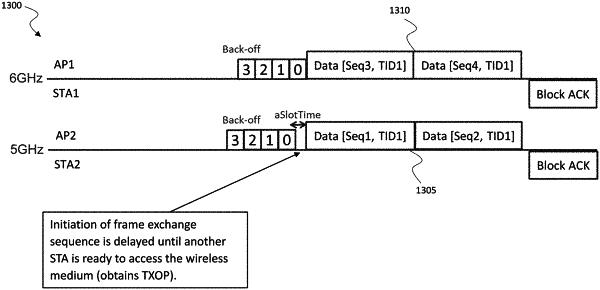| CPC H04W 74/0891 (2013.01) [H04L 1/0008 (2013.01); H04W 56/001 (2013.01); H04W 74/0816 (2013.01)] | 13 Claims |

|
1. A method of transmitting data over a wireless network by a multi-link device (MLD), the method comprising:
performing independent enhanced distributed channel access (EDCA) channel access at the multi-link device on a first wireless link and on a second wireless link, wherein the multi-link device comprises:
a first wireless station (STA) associated with the first wireless link; and
a second wireless STA associated with the second wireless link;
determining that a back-off counter of the first wireless link has reached 0;
obtaining a TXOP on the first wireless link;
determining that the second wireless STA has not yet obtained a TXOP on the second wireless link;
delaying a frame exchange sequence over the first wireless link until a back-off counter of the second wireless link has reached 0;
determining that the back-off counter of the second wireless link has reached 0;
responsive to determining that the back-off counter of the second wireless link has reached 0, obtaining a TXOP on the second wireless link;
responsive to the obtaining a TXOP on the second wireless link, performing a multi-link operation at the multi-link device using the first wireless link and the second wireless link when physical carrier sensing and virtual carrier sensing indicate that the first wireless link is idle;
initiating the frame exchange sequence over the first wireless link during the TXOP on the first wireless link; and
initiating a frame exchange sequence over the second wireless link during the TXOP on the second wireless link.
|